New England Fall Foliage | 2024 Forecast
Ready for another New England fall foliage season? Our forecaster predicts a big show with bold color! Read on for the full 2024 New England fall foliage forecast.
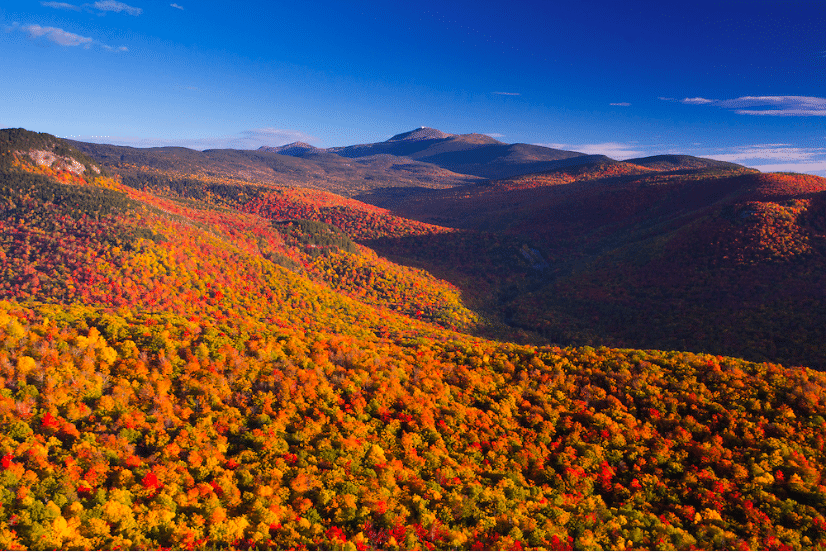
The White Mountains of New Hampshire
Photo Credit : Jim SalgeIt’s amazing how a good year gets people talking.
The Celtics had a good year, but that’s not what I’m referring to. Before the team concluded its incredible run in June, the magnolias, cherry blossoms, and lilacs of New England had a long-lasting, vibrant, and fragrant year. Then the hydrangeas put on a massive display. Large corymbs of blue and purple flowers bloomed across the region from Burlington to Cape Cod, and we all sure took notice!
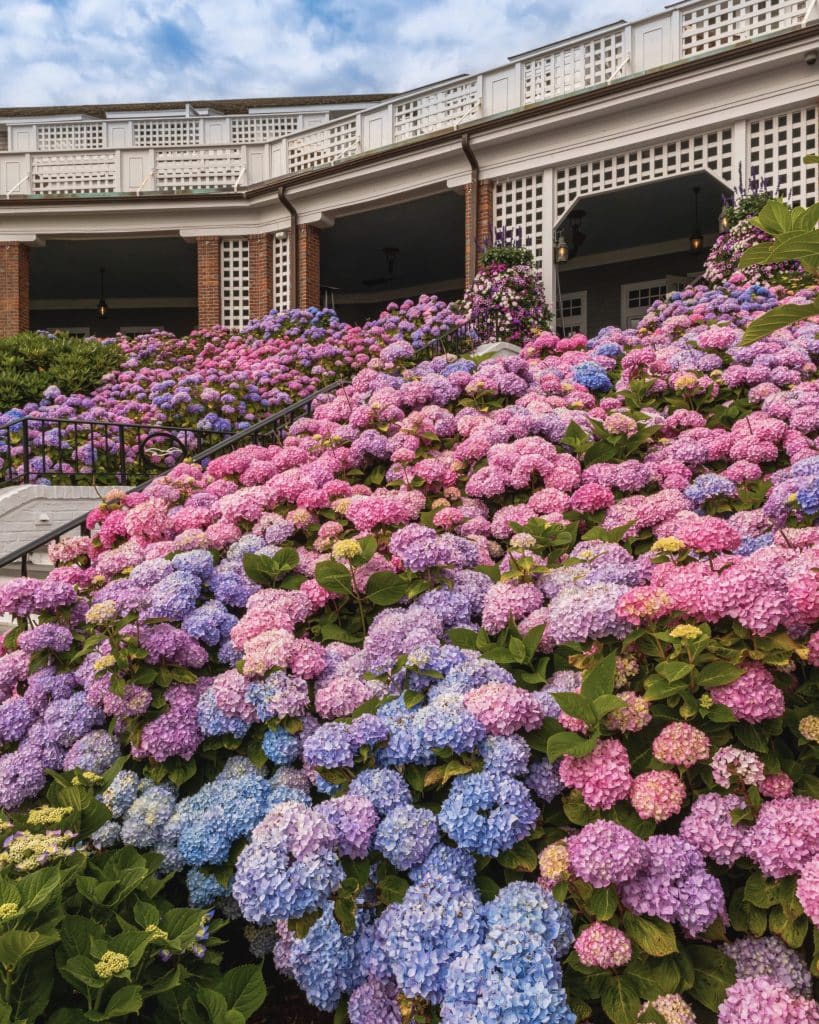
Photo Credit : Jack Cohen
Just as there are foliage experts, there are hydrangea experts, too — and their explanation for this spectacular season sounded very similar to our annual foliage report. A few successive years of failed blooms meant that plants had a surplus of energy. Last summer’s wet summer left plants primed, and a mild winter preserved every dormant bud. In short, several factors in a complex system all came together for a dazzling display.
We’re just over a month away from seeing the first fall colors cascade across New England, and it’s time to address the annual question: Will it be a good foliage year? Fortunately, the colors here are always beautiful, although no two years are identical. Some years are brighter, some more muted, and displays can be durable or delicate.
As with the hydrangeas and magnolias, we are looking for a good year for foliage … and complex and often competing factors will determine when and where the colors will pop!
So, what will this year be like?
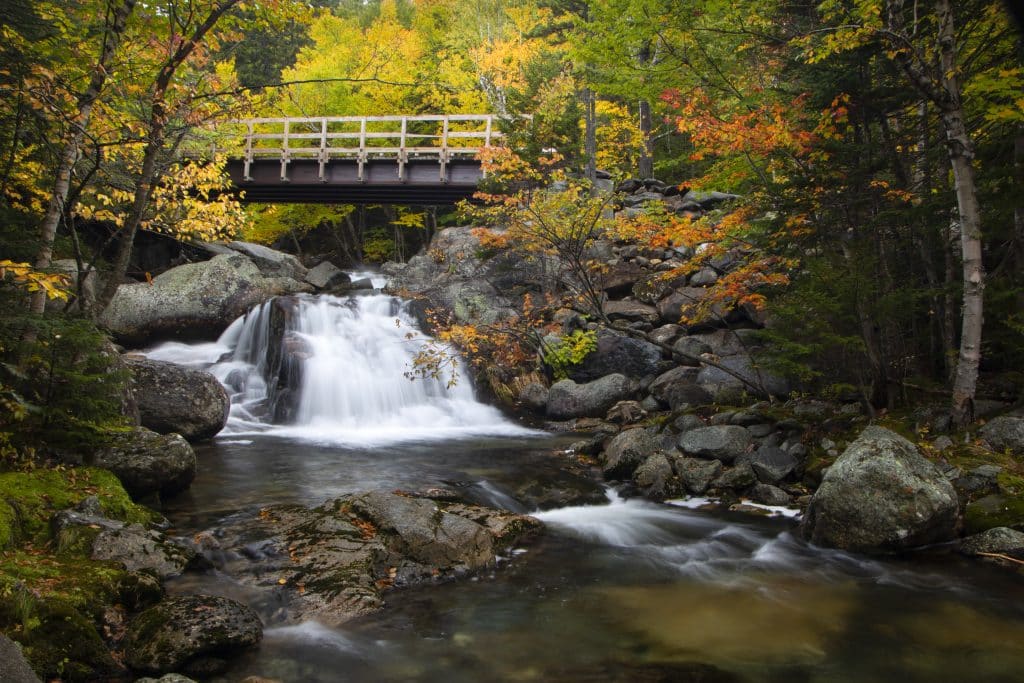
Photo Credit : Jim Salge
New England Fall Foliage 2024 | Influences
Weather & Climate
New England’s famed foliage show is best when optimal growing conditions come together with optimal fall conditions, and that’s all down to the weather. Last summer, the rains wouldn’t stop, leading to a lot of fungus in the fall that muted much of our display, but the trees had a long season in which to store energy for this year.
This past winter saw frequent rain, little snowfall, and almost no consistent snowpack beyond the mountains. Normally, without any insulation on the ground, many plants would have been at risk — but it was also one of the mildest winters on record. Temperatures in Concord, New Hampshire, never fell below zero, and the low temperature for the entire winter in Boston was only 14F. Then, just when an early spring looked imminent, we had a big April snowstorm right before the total solar eclipse on April 8, 2024.
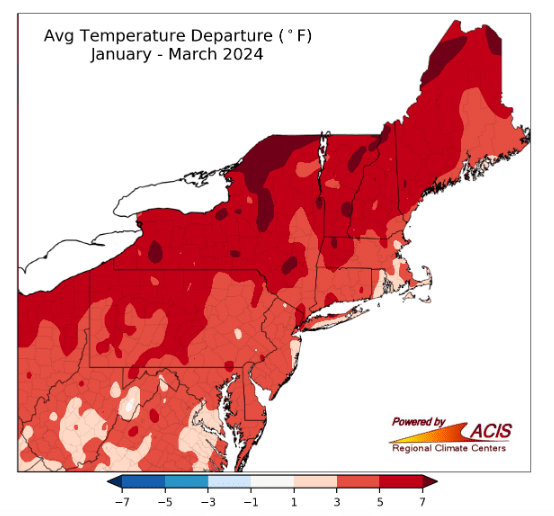
As a result, the spring green-up came slowly, with long-lasting flowers and cool weather. One last cold snap in early May threatened the apples and peaches yet again, but disaster was averted, perhaps by a degree. Warm weather arrived for good by mid-May, and with adequate rainfall, the trees and leaves were off to a great start.
This summer has continued to be warm and very humid. Rainfall has been divided north and south, with constant rain and catastrophic flooding in northern Vermont, while 150 miles away there is a moderate drought. But the growing season has been good overall, with little sign of drought stress or significant overwatering. Only persistent humidity remains a concern, due to leaf fungus.
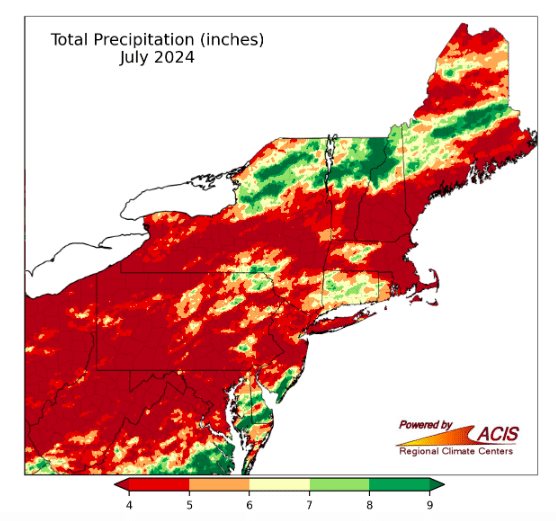
New England Fall Foliage 2024 | Wildlife
Flowers & Seeds
Last year, trees spent a lot of their resources producing seeds (also known as mast), and there’s significant anecdotal evidence that this left them more vulnerable to the onslaught of fungi that arrived late last year. This year, there are far fewer maple and beech seeds, so the trees should be able to use their excess energy for growth, repair, and defense.

Photo Credit : Jim Salge
The lone exception in the forest is the red oak, which is producing numerous, huge acorns across much of its range. Red oaks are among the last trees to turn their fall colors, and are all but absent from much of the far-northern forests, so the impact on foliage will be minimal. Lastly, let’s celebrate peaches in New England: They’ve had a rough few years, but this year they are back — and delicious!
Bugs & Fungi
The multiyear outbreak of the spongy moth caterpillar (formerly known as the gypsy moth) has abated across most of the region, and trees are recovering. Overall, there has been very little defoliation caused by caterpillars this year. Unfortunately, other pests are taking center stage, with the expansion of the emerald ash borer and beech leaf disease, which is caused by microscopic roundworms. These two will have a significant effect on New England’s forests.
Leaf fungus impacted last year’s foliage season, but there are many reasons to believe that it won’t be as bad this year. Spring saw normal rainfall, with stretches of dry weather that limited growth. And despite oppressive humidity, rainfall has been much lower this year, except in northern Vermont. However, with so many spores around last year, there’s a higher risk that they overwintered and will cause reinfection, something that bears watching. This is precisely what happened to the white pine trees this spring, which saw considerable browning.
New England Fall Foliage 2024 | Long-Range Outlook
So far, the setup suggests that New England’s fall foliage outlook is fairly bright, but fall conditions need to continue to cooperate. Fall colors are brought out best by warm, sunny days and crisp, cool nights. This combination not only accelerates the demise of green chlorophyll, but also initiates the formation of red color pigments, which are only produced during these conditions.
The El Niño of last winter has come and gone, and we are expected to be in a neutral Pacific pattern at autumn’s onset. With this pattern, climatologists note a more stable west-to-east flow in the jet stream and fewer extreme shifts in the weather. Temperature and rainfall trends tend to follow a normal seasonal progression. However, the Northeast has already been warm this year due to other global patterns, and a neutral pattern does little to steer tropical activity away from the region. We recently had the remnants of two tropical systems swing through, and we don’t want a third.
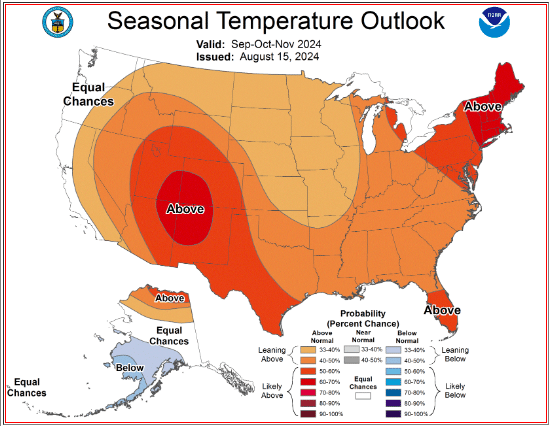
The Climate Prediction Center continues a forecast of warm and wet into our autumn, which could stall the progress of fall colors across much of New England. However, even in a warm pattern, the normal onset of cool nights could dominate in a neutral year.
New England Fall Foliage 2024 | The Official Forecast
The fall foliage in New England rarely disappoints, as the famed colors are consistently brought out by the region’s favorable climate and great autumn weather. Some years are better than others, but we see a fairly positive set of circumstances surrounding this year’s prospects. The forest looks healthy, vibrant, and full of energy, and therefore primed for a big show.
Spring was timely, and leaves grew well without pests or fungi. Summer has continued that trend, without much tree stress outside of rain-stricken northern Vermont (though we are quickly editing to add Connecticut to that category, too). And even there, we expect a lot of early color this year in the swamp maples, which are starting to turn already, providing pops of red in otherwise green forests from now through mid-September.
When the weather does turn cool, which should happen on a fairly normal timetable in northern New England this year, the chlorophyll will respond to the diminished light and let the brilliant colors shine through underneath. Our confidence in the upcoming season is also increased with the knowledge that the past few neutral Pacific ENSO (El Niño–Southern Oscillation) years have had great, early, and lasting color, especially 2019 — which coincidentally was also very humid during the summer. The only substantial risks we’re seeing to threaten the brightness of this year’s show are persistent warmth through September, and continued humidity and tropical systems to activate the latent fungi.

Photo Credit : Jim Salge
In summary, we expect peak color to develop on time in northern New England, compared with historical averages, with the onset of cooler weather. Colors should be bright, and trending toward a redder year if abundant sunshine allows. Colors should hang on longer than normal before fading and falling slowly. Farther south and along the coast, cooler weather may struggle to advance amid the overall warmer fall pattern, and the color might arrive slightly late compared with the average. Foliage hues should be just as bold there, too, but we are watching for leaf fungus during the next month. Overall, the best areas should be the Berkshires and central Green Mountains, as well as much of the White Mountains and western Maine. A bonus bright spot later in the season may be eastern Massachusetts, where it’s been some years since a real “good show”!
New England Fall Foliage 2024 | What’s Next?
At NewEngland.com, we offer many tools to help you plan your visit and stay abreast of the changing leaves as they happen! We have extensive ideas for road trips, a map predicting peak foliage, and weekly travel picks throughout the season.
Things to look for in our September update:
1) Will cool nights and warm, sunny days arrive on schedule?
2) Is leaf fungus going to set up, dulling the fall display a bit?
3) Will tropical systems stay away?
We will let you know. And we can’t wait to share the season with you!
Beyond New England | National Foliage Predictions
Mid-Atlantic and New York
New York state has followed a similar pattern to New England’s, with perhaps even less snowfall compared with normal. They’ve had a good growing season, too, though, and should be primed for a good show that arrives close to historical averages. The rest of the Mid-Atlantic should be on time or late except for a pocket of severe drought near the Blue Ridge Mountains that could throw a wrench in that display. There’s still time, though … hope for rain.
Southeast
The pocket of drought at the top northern edge of the southern Appalachians is the exception in this region, where the rainfall has been adequate. A recent tropical system ended any talk of drought otherwise. Look for warm weather into fall, and great weather in the mountains for a good fall color display.
Upper Midwest
This region saw a very mild winter, with Midwestern ski resorts suffering all season. Much like New England, though, cooler weather in the spring stalled the advancing wave of early leaf-out, and the season has played out well, with little drought. A great show is expected.
Mountain West
It’s been a generally nice summer in the Rockies, with adequate rain and reasonable temperatures. The only drought in the Mountain West is in places without many trees. The long-range outlook is warm and dry, however, which could make for a brief, bright foliage season. Note: Utah may have a particularly vibrant autumn.
Pacific Northwest
In contrast to the rest of the West Coast, the Pacific Northwest has been abnormally dry, especially in the mountains. The long-range outlook, though, is seasonable and wet, so conditions should balance out. Maybe there will be an early show for the larches in the Cascades, but the rest of the area should be right on time.
Jim Salge
As a former meteorologist at the Mount Washington Observatory, foliage reporter Jim Salge is a keen observer of the progression of the seasons in New England. He uses his knowledge of weather, geography and climate to pinpoint the best time to visit various New England locations to find the best light, atmosphere, and most importantly, color.
More by Jim Salge

